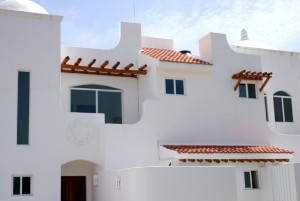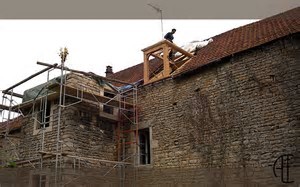25 Apr New fiscal stimulus initiatives in Spain aimed at the home rehabilitation sector
(Google translation from Noticias Vlex.com)
 The Congress of Deputies validated by a majority a number of fiscal stimulus initiatives aimed at the home rehabilitation sector that were included in the Royal Decree on Measures to Promote Economic Recovery and Employment, approved on Friday April 9 by the Council of Ministers.
The Congress of Deputies validated by a majority a number of fiscal stimulus initiatives aimed at the home rehabilitation sector that were included in the Royal Decree on Measures to Promote Economic Recovery and Employment, approved on Friday April 9 by the Council of Ministers.
The government expects that the tax package has a strong leverage effect on the construction sector, which together with other government initiatives, such as the reform agenda in public buildings to improve energy efficiency, “serve to contribute to employment generation.
These tax measures will help further the goal of efficiency and energy savings made by the Government in the framework of the Strategy of Sustainable Economy.
DEDUCTION FOR NEW CONSTRUCTION IN THE PIT
The first of these reforms is the new temporary income tax deduction for improvement works in the residence. This will be deducted up to 10% of the amounts to be invested between April 14, 2010 (date of entry into force of Decree-Law) and December 31, 2012 on actions to improve the residence, or building in which it is found, with a total limit of 12,000 euros per household. The annual limit per taxpayer is € 4,000.
To be eligible for this deduction the vast majority of taxpayers, with the exception of those with a higher tax base to 53007.20 euros, representing only 5% of the total. The deduction is most effective on taxpayers with taxable income exceeding 33007.20 per year, as they may apply the 10% deduction on the basis of the prescribed annual maximum of € 4,000 per taxpayer. As the income level of taxpayers go on increasing this limit, the basis of the deduction will be reduced to zero when it exceeds the taxable EUR 53007.20.
To optimize the effectiveness of tax incentives, will be allowed to the amounts paid by a taxpayer during a period that cannot be deduced by the application of the base annual maximum of 4,000 euros established, can be derived, with the same annual limit during the four subs.
In any case, the amount subject to deduction for all applicable tax periods that apply not exceed 12,000 euros per residence. In cases where there is more homeowners eligible for the deduction on a same property, the limit of 12,000 euros will be distributed among the joint owners according to their respective percentage ownership in the building.
 In line with the provisions of the State Housing Plan and Rehabilitation 2009-2012, allowed to benefit from this new tax incentive works aimed at improving the energy efficiency of the home (installing solar panels, improved insulation of windows, change …), shower bath by consolidating security and sealing of buildings (replacement of facilities of electricity, water or gas), to improve the accessibility (lifts adapted to the needs of people with disabilities, installing ramps. ..) and install new telecommunications infrastructure to provide access to the Internet or digital television services in the homes of taxpayers.
In line with the provisions of the State Housing Plan and Rehabilitation 2009-2012, allowed to benefit from this new tax incentive works aimed at improving the energy efficiency of the home (installing solar panels, improved insulation of windows, change …), shower bath by consolidating security and sealing of buildings (replacement of facilities of electricity, water or gas), to improve the accessibility (lifts adapted to the needs of people with disabilities, installing ramps. ..) and install new telecommunications infrastructure to provide access to the Internet or digital television services in the homes of taxpayers.
On the contrary, works carried out in parking lots, gardens, swimming pools, sports facilities and other similar items shall not be entitled to deduct, nor will change of furniture of the kitchen cabinets do or wear, replace tiles, paint , throwing bricks or change soils.
It is important to note also that the incentive can be applied only on the amounts paid by credit or debit card, bank transfer, check or income accounts of credit institutions, not when the services are paid in cash. This caution has as main objective to collaborate in the prevention of tax evasion and labor.
Taxpayers may not get the benefits of this new tax relief from the Income tax Statement, 2010 (to be made in 2011) and therefore they cannot apply that in this exercise. It is therefore important to retain the invoices received by the work involved to justify the investment.
In this regard, it will be retained as proof of payment method chosen as the invoice, which shall contain the following information: number and number of the same, the date of issue and date of completion of the operation if two do not coincide, name and first name of the consignor and consignee, NIF and address of the consignor and, where appropriate, the consignee detailed description of the action taken, type or VAT rates and tax charged VAT.
REDUCED VAT RATE FOR REPAIR WORKS
The second major tax incentive is the reduced rate of 7% (8% from July 1) of the VAT for all types of renovation and repair of private housing to be made between 14 April 2010 31 December 2012. So far, the scheme only applied to the masonry, and the rest were applied to 16%. With this new framework, it will also benefit from the actions of plumbing, carpentry, installations and fittings, electricity or painting and, in general, all the reforms made in housing, whatever their purpose.
The Royal Decree establishes three requirements to qualify for the new tax scheme. First, the recipient is an individual and that the works are directed towards a particular purpose, and not a business or professional. This requirement will also operate when the recipient is a community of owners and the works are made in the building where is the private dwelling. Second, the construction or rehabilitation of housing where the works are finished at least two years before the start of the renovation or repair.
The third requirement is that the incentive applies to those who do not provide material works costing more than 33% of the taxable amount of the transaction. For example, if the work in question was the placement of the floor of a house and the same total cost amounted to $ 10,000, you may apply the reduced rate if the material used does not exceed 3,300 euros. If the materials provided exceed that amount, the rate applicable to such work is the normal 16%. Until the present Decree Law, the limit of the material was 20%.
The invoice must state the cost of materials supplied or the condition that this cost does not exceed 33% of the tax base.
EXTENSION OF THE CONCEPT OF REHABILITATION IN THE VAT
The other axis of action to promote the activity in the area of housing rehabilitation is extending the concept of structural rehabilitation for VAT purposes, through the definition of similar works and related to structural, which will reduce tax costs economic activity associated with rehabilitation.
The old law already took these concepts, but did not give them an adequate definition, which prevented, in many cases, the application of reduced rates in certain actions related to rehabilitation. The definition of these concepts in the decree law that goes into effect now will not only improve legal certainty for businesses, but will significantly reduce your tax costs.
 So, since last April 14 and remain in force indefinitely extending the concept of structural rehabilitation, which applies the reduced rate of 7% (8% from July 1) to the works of rehabilitation of buildings, including premises attached garages, additional facilities, provided that more than 50% of the building is intended for private homes.
So, since last April 14 and remain in force indefinitely extending the concept of structural rehabilitation, which applies the reduced rate of 7% (8% from July 1) to the works of rehabilitation of buildings, including premises attached garages, additional facilities, provided that more than 50% of the building is intended for private homes.
To be considered for rehabilitation, the cost of works should not exceed 25% of the purchase price of the building (if it was made in the two years prior to rehabilitation) or market value, less in both cases land value. Also, over 50% of the actions envisaged in the project will include reconstruction of the building or in carrying out similar works or related to those.
Consideration will be given to works like structural adjustment actions that serve to ensure stability and mechanical strength of the building, the reinforcement of the foundations, the expansion of built-up area, the reconstruction of facades and patios of interior and installation of elevators. Related works will be considered, for their part, masonry, plumbing and carpentry, measures to improve facilities and enclosures or energy rehabilitation works.
The decree provides, finally, the reform of the Canary Islands General Indirect Tax in the same sense that the VAT on materials which are appropriate to state regulation, so that the tax benefits resulting from these changes reach the entire territory.



Sorry, the comment form is closed at this time.